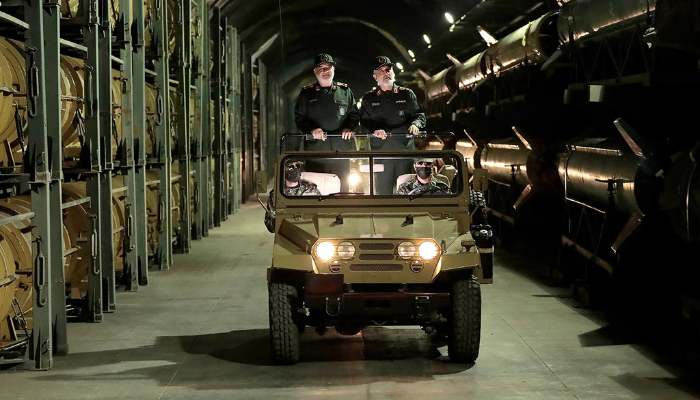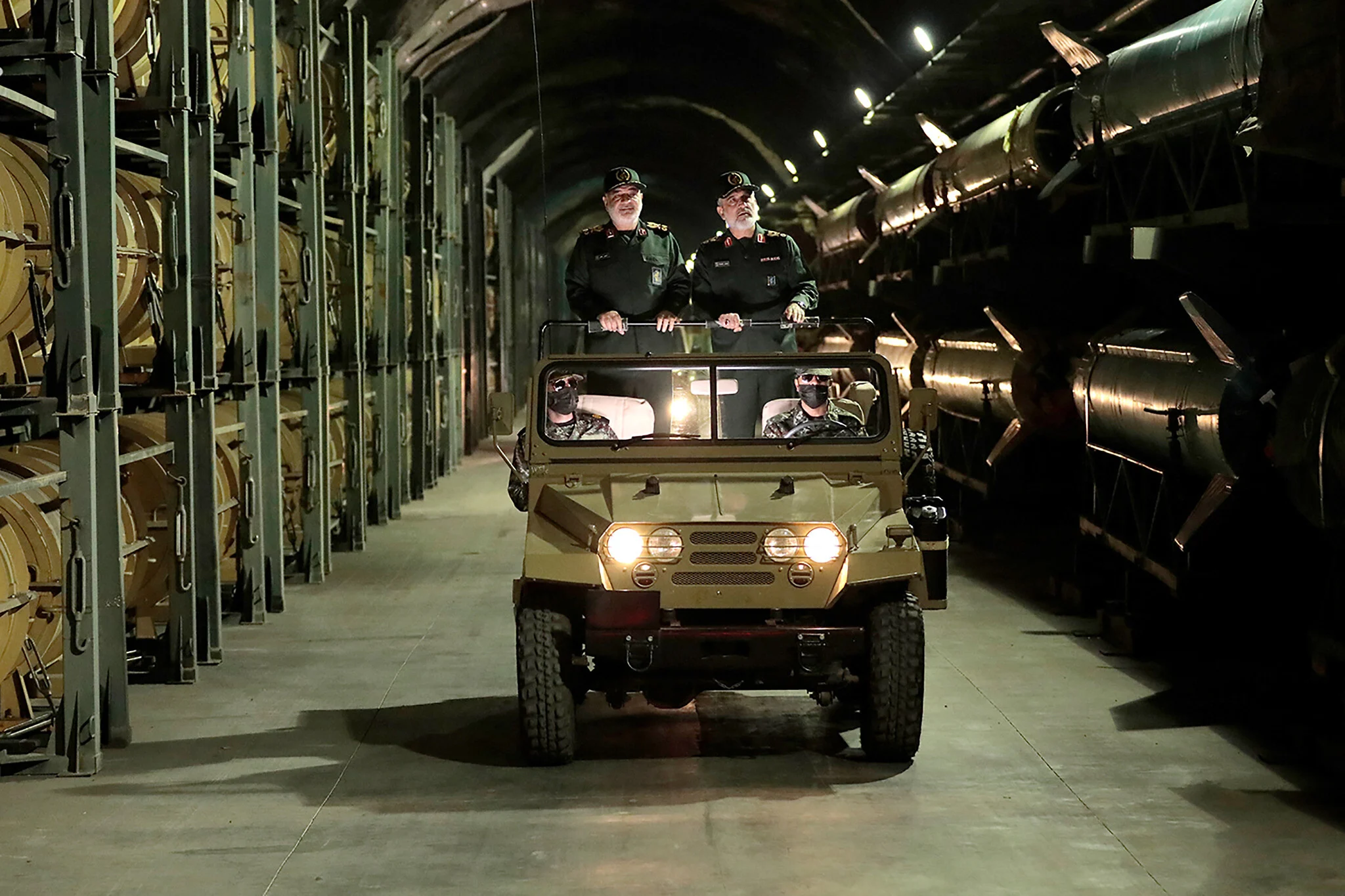
In a bold move signaling its defiance of international pressures, Iran has unveiled its third underground missile facility, a site the country has dubbed “Missile City.” This move comes at a time of heightened tensions with the United States, as the deadline for former President Donald Trump’s ultimatum on Iran’s nuclear program draws nearer. The highly anticipated reveal underscores Iran’s ongoing determination to enhance its military capabilities despite growing diplomatic and military pressure.
The missile facility, shown in a video broadcast by Iranian state media, is a testament to the country’s growing focus on missile development. The footage features top military commanders, including Major General Mohammad Hossein Bagheri, Iran’s Chief of Staff of the Armed Forces, and Amir Ali Hajizadeh, the commander of the IRGC Aerospace Force, as they tour the expansive underground complex. The video, which lasts for just 85 seconds, provides a glimpse into the vast network of tunnels designed to house advanced missile systems, all of which are intended to significantly bolster Iran’s defense capabilities.
Strategic Importance of the Missile City
The facility’s unveiling marks a significant step in Iran’s military development. With an array of advanced missiles, including the Kheybar Shekan—a sophisticated long-range missile—this underground base represents a critical component of Iran’s military strategy. The facility is designed to be a stronghold for missile stockpiles, offering protection against potential airstrikes or missile attacks. The underground storage facility provides Iran with a strategic advantage, enabling it to protect and hide its most sophisticated weaponry deep within the earth.
By showcasing these missiles, Iran sends a clear message of strength and resilience to the US and its allies, particularly Israel, which has been vocal about its opposition to Iran’s growing military capabilities. The missiles displayed at the “Missile City” are capable of reaching targets deep within enemy territory, adding a layer of deterrence to Iran’s defense posture. The Kheybar Shekan missile, for instance, has been touted as one of Iran’s most advanced and potent weapons, able to deliver significant payloads to strategic targets at long ranges.
Exposing Vulnerabilities
Despite the impressive scale and design of the missile complex, experts and analysts are pointing out some of the facility’s vulnerabilities. The storage and structural design of the complex, while highly fortified, could be susceptible to high-intensity strikes. Airstrikes or missile hits from the US or Israeli forces, for example, could potentially target key structural weaknesses within the tunnels. These vulnerabilities raise concerns about the effectiveness of such underground facilities as a long-term defense strategy.
While the complex is deeply buried to avoid detection and destruction, experts caution that no facility is entirely invulnerable to modern warfare technologies. Advanced satellite surveillance, precision-guided munitions, and cutting-edge intelligence capabilities could potentially compromise the security of such underground bases. Additionally, the sheer size of the “Missile City” may make it more difficult to protect all of its critical components simultaneously.
Political Context: US Pressure and Nuclear Deal Tensions
The timing of the unveiling could not be more politically charged. The development of this new facility comes as the deadline for former President Trump’s nuclear deal ultimatum approaches. In 2018, Trump pulled the United States out of the Joint Comprehensive Plan of Action (JCPOA), the landmark 2015 nuclear deal, and imposed stringent sanctions on Iran. He demanded that Iran abandon its nuclear program or face further international isolation and pressure.
With the deadline for compliance fast approaching, this move by Iran to showcase its missile prowess appears to be a calculated step in the ongoing standoff. By unveiling this missile facility, Iran may be attempting to demonstrate its strength and resolve in the face of mounting diplomatic and military pressures. The move also signals to the international community that Iran is prepared to continue its defense development independently of any nuclear deal negotiations.
Iran’s defiance is clear—while the country may be willing to engage in diplomatic talks, it is also keen on maintaining its military independence and technological advancements. This unveiling is a stark reminder that, for Iran, military preparedness is just as vital as its nuclear ambitions. It underscores the complex balancing act Iran faces between pursuing nuclear capabilities and safeguarding its military interests.
International Reactions and Diplomatic Fallout
The unveiling of “Missile City” is likely to raise concerns among both US officials and their allies, particularly in Europe and the Middle East. Israel, which has long been an outspoken critic of Iran’s nuclear and missile ambitions, has already expressed alarm over the facility. Israeli Prime Minister Benjamin Netanyahu has previously warned that Iran’s missile and nuclear programs pose a direct threat to regional stability and security.
US officials, who have been engaged in tense negotiations with Iran over the fate of the nuclear deal, are likely to interpret the unveiling as a provocative gesture. The US has consistently sought to limit Iran’s missile capabilities, citing them as a destabilizing factor in the Middle East. While the US administration under President Joe Biden has attempted to revive the nuclear deal, Iran’s continued missile development complicates the prospects for a successful resolution.
The European Union, which has played a role in mediating talks between Iran and the US, may also find itself in a difficult position. While European nations have been more supportive of diplomatic engagement with Iran, the unveiling of such an advanced military facility could lead to increased calls for tougher sanctions or a hardline stance in future negotiations.
A Symbol of Iran’s Military Resilience
The “Missile City” is not only a physical manifestation of Iran’s military resilience, but it also represents the country’s broader strategic priorities. Iran has increasingly invested in asymmetric warfare tactics, including the development of missile systems, to counterbalance the technological superiority of adversaries like the US and Israel. The facility’s vast network of tunnels is symbolic of Iran’s commitment to maintaining a robust and flexible defense infrastructure.
While the facility may be a source of national pride, it also serves as a reminder of the increasingly tense geopolitical climate in the region. As the deadline for the nuclear deal draws closer, the stakes for both Iran and the US grow higher. Whether this unveiling will push the parties closer to a resolution or further entrenches their positions remains to be seen. However, one thing is certain: Iran’s military ambitions are far from being curtailed, and the unveiling of “Missile City” is just one chapter in this ongoing saga.

